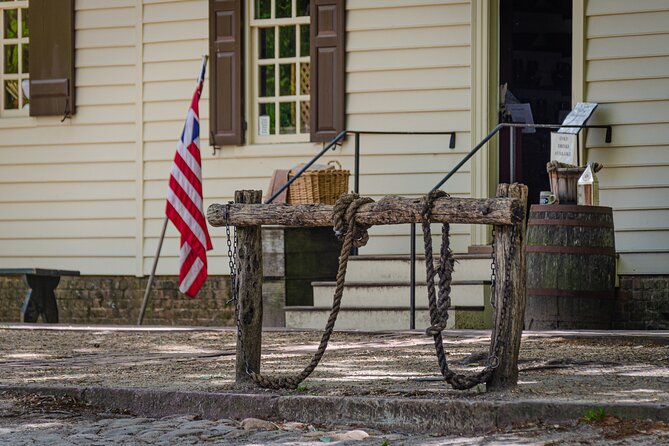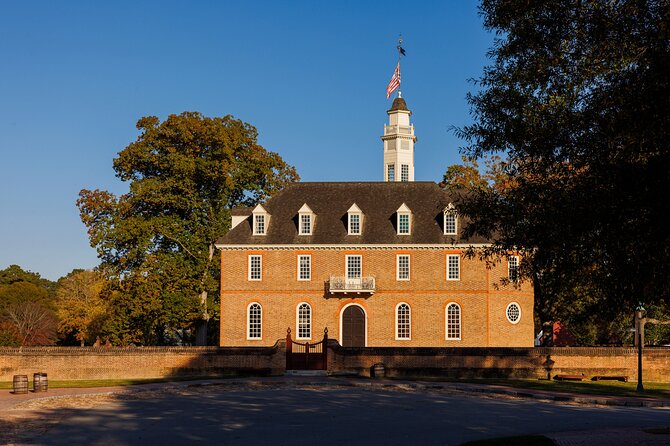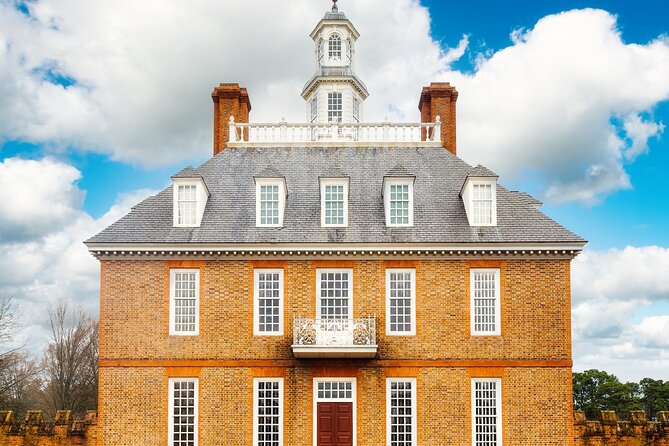Williamsburg’s historic streets hold a dual narrative – one of early American prosperity and another of profound injustice. Behind the colonial-era facades, the shadows of slavery’s legacy linger, reminding visitors of the systemic dehumanization that fueled the region’s economic growth. As we uncover the grim realities faced by the enslaved individuals who toiled in the Geddy family’s silversmith shop, we’re confronted with the harsh conditions they endured and the resilience they displayed. This troubled history continues to shape Williamsburg’s social and cultural landscape, inviting deeper reflection on the lasting impact of slavery in America.
Key Points

- Williamsburg’s colonial-era architecture and history provide a window into the social dynamics and troubling legacy of slavery in 18th-century America.
- Enslaved individuals endured brutal conditions, dehumanizing treatment, and backbreaking labor that were crucial to the colonial economy’s prosperity.
- The Geddy family’s reliance on an enslaved workforce for their household and business operations exemplifies the complexities of slavery in the region.
- Slaves suffered from physically demanding work, inadequate living conditions, severe punishments, and constant threat of family separation, reflecting the everyday hardships of their lives.
- Slavery’s enduring influence shaped Williamsburg’s development, political landscape, and social fabric, underscoring its inextricable connection to the region’s past.
Understanding Williamsburg’s Historic Significance

As a historic epicenter of 18th-century colonial America, Williamsburg played a pivotal role in the nation’s founding.
The city’s colonial-era architecture, storied streets, and rich history provide a window into the complex social dynamics of the era, including the troubling legacy of slavery.
Visitors can explore the city’s meticulously preserved historic district, which includes landmarks like the Governor’s Palace and the Courthouse.
You can also read our reviews of more tours and experiences in Williamsburg.
Uncovering the Realities of Slavery in Colonial Times

Williamsburg’s colonial-era history is inseparable from the realities of slavery that permeated the region. The tour uncovers these harsh truths, offering a window into the lives of the enslaved people who toiled on plantations and in households.
The tour highlights:
-
The brutal conditions and backbreaking labor endured by enslaved individuals.
-
The systemic dehumanization and lack of autonomy experienced by the enslaved.
-
The crucial role of enslaved labor in maintaining the colonial economy and lifestyle of the elite.
-
The lasting impacts of slavery’s legacy, which continue to shape the region’s social and economic landscape.
Exploring the Geddy Family’s Enslaved Workforce
The Geddy family, prominent members of colonial Williamsburg’s elite, relied extensively on the labor of enslaved individuals to maintain their household and business operations.
These enslaved workers toiled in the Geddys’ silversmith shop, tended the family’s livestock, and performed domestic duties within the home.
Archival records reveal the names and approximate ages of some of the Geddys’ enslaved workforce, providing a glimpse into the lives of those who were forced to support the prosperous lifestyle of their enslavers.
Understanding this historical context is crucial to appreciating the complexities and lasting impacts of slavery in colonial Virginia.
Confronting the Harsh Conditions Endured by Slaves

Though the Geddy family’s wealth and prominence in colonial Williamsburg were built upon the labor of enslaved individuals, their everyday lives were marked by unrelenting hardship and brutal treatment.
Slaves endured:
-
Physically demanding work, often from dawn to dusk, with limited breaks or rest.
-
Inadequate food, clothing, and shelter, leading to poor health and living conditions.
-
Severe punishments, including whipping, imprisonment, and mutilation, for perceived infractions or disobedience.
-
Separation from family members, as slaves were frequently bought, sold, or relocated at the whim of their owners.
Recognizing the Resilience and Resistance of the Enslaved

Despite the harsh conditions they faced, the enslaved individuals in Williamsburg often displayed remarkable resilience and resistance.
They found ways to preserve their culture, family ties, and humanity in the face of dehumanization. Some organized secret meetings and engaged in acts of sabotage or escape.
Others used creativity, such as quilting, to subvert the system. The enslaved also demonstrated psychological resilience, maintaining hope and a sense of self-worth.
Their stories of survival and defiance serve as a testament to the indomitable human spirit and continue to inspire efforts to confront the legacy of slavery.
- The Original Ghosts of Williamsburg Tour
- Jamestown Settlement American Revolution Museum 7-Day Ticket
- Colonial Ghosts Tour By US Ghost Adventures
- Exclusive Private Tour of Colonial Williamsburg and the College
- Colonial History Tour in Williamsburg Virginia
- Ultimate Pirate Walking Tour in Colonial Williamsburg
Tracing the Lasting Impact of Slavery on Williamsburg’s Development
Slavery’s pervasive influence shaped Williamsburg’s development in lasting ways. The town’s colonial architecture, economic structure, and social dynamics all bore the imprint of the slave system.
Four key ways slavery impacted Williamsburg’s growth include:
-
Labor-intensive industries like tobacco cultivation depended on enslaved workers.
-
Wealthy plantation owners influenced the town’s political and cultural landscape.
-
Segregated living spaces and restricted mobility for the enslaved perpetuated racial divides.
-
The wealth generated by slavery enabled the construction of grand homes and public buildings.
These enduring legacies underscore how inextricably slavery was woven into Williamsburg’s past.
Reflecting on the Ongoing Legacy of Slavery in America
The shadow of slavery continues to loom over America, with its complex and enduring legacy profoundly shaping the nation’s social, economic, and political fabric. From systemic inequalities to ongoing racial tensions, the vestiges of slavery remain deeply entrenched in contemporary society. Addressing this legacy requires a multifaceted approach, one that acknowledges the past, confronts the present, and envisions a more equitable future. As we reflect on the lasting impact of slavery, the following table highlights key areas where its influence persists:
| Area | Impact |
|---|---|
| Economic | Wealth disparities, access to opportunities |
| Social | Racial prejudice, lack of representation |
| Political | Voter suppression, structural barriers |
Embracing the Opportunity for Dialogue and Reconciliation

Embracing the opportunity for dialogue and reconciliation presents a path forward in addressing slavery’s enduring legacy.
By fostering open discussions, communities can:
- Acknowledge the historical trauma and its ongoing impacts.
- Facilitate understanding across diverse perspectives.
- Identify tangible steps for reparation and healing.
- Promote a shared vision of justice and equity.
This approach invites all members of society to engage in the challenging yet necessary work of confronting the past, recognizing its present-day consequences, and collaboratively shaping a more inclusive future.
Only through this collective effort can the shadows of slavery’s legacy begin to recede.
Frequently Asked Questions
Can I Bring My Own Food and Drinks on the Tour?
Food and drinks are generally not allowed on the tour, as the focus is on the guided experience. However, the tour provider recommends checking their policies or contacting them directly if you have any special requirements or needs.
Is the Tour Suitable for Children?
The tour seems suitable for most travelers, but it’s not explicitly mentioned if children are allowed. It’s best to check with the tour provider for their policy on minors and any age restrictions or recommendations.
How Long Does the Tour Last?
The tour lasts approximately 2-3 hours, allowing visitors ample time to explore Williamsburg’s historical sites and uncover the legacy of slavery in the region with a knowledgeable local guide.
Is There a Dress Code for the Tour?
There is no specific dress code for the tour. Visitors are encouraged to wear comfortable walking shoes and clothing suitable for the weather, as the tour involves walking outdoors. Casual attire is appropriate for this private tour activity.
Are There Any Discounts Available for the Tour?
The tour provider does not explicitly advertise any discounts. However, group rates are available, which can reduce the per-person cost for larger parties. Interested travelers should check with the provider to inquire about any applicable discounts or promotions.
Sum Up
Williamsburg’s historic preservation illuminates a complex past, where the opulence of colonial prosperity was built upon the dehumanizing realities of slavery. This troubled legacy continues to shape the community, underscoring the need for ongoing dialogue and understanding. By confronting the shadows of the past, Williamsburg can forge a path towards greater reconciliation and a more inclusive vision for the future.
More Tour Reviews in Williamsburg
Not for you? Here's more nearby things to do in Williamsburg we have reviewed
- Williamsburg’s Famous Ghosts Self Guided Audio Walking Tour
- Night Watchman’s Ghost Tour
- Private Tour From Williamsburg to Monticello World Heritage Site
- Williamsburg Family Trek A Journey Through Time and Tales
- Tales of Christmas Past and Present in Williamsburg
- Secret Lives on Colonial Women
- Williamsburg’s Winter Wonderland: A Historic Holiday Stroll
- What Says Virginia: A Question of Independence Review
- A Woman’s Place in History Review
- Epic Scavenger Hunt in Williamsburg Review
- Colonial Williamsburg Dead of Night Ghost Hunt With Equipment
- The Reverend and the Millionaire
